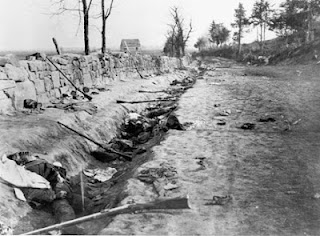 |
| The Sunken Road, photo by Lori Korleski Richardson |
Here in December 1862, the Union Army attacked the Confederate forces led by Robert E. Lee. The federal soldiers crossed the Rappahannock River, and took the town of Fredericksburg. But when the Union soldiers charged up Marye’s Heights, on the western side of town, they were met with ferocious fire from rebels entrenched on a road behind a stone wall.
This killing field became known as the Sunken Road.
The total killed or wounded at the Battle of Fredericksburg: 18,000 on both sides in four short days. The Union casualties just at the Sunken Road was 7,000 dead and wounded. The bodies were piled deep, the blood soaked the ground, and most were ever after identified with a number on a stone grave marker.
 |
| Sunken Road, photographed 1863 |
Since moving to Virginia four years ago, we’ve been to Harper’s Ferry, Appomattox Courthouse, Chancellorsville, Spotsylvania, Gettysburg, and now Fredericksburg.
During the course of war, there were four major battles near Fredericksburg, and by war’s end 105,000 soldiers were killed or wounded in the immediate vicinity.
In each of these places, I am continually struck by how small these battlefields are. Huge armies crashed into each other in very confined spaces. The Napoleonic tactics of an earlier age met the industrialized warfare of a later age, and the results were lethal on an enormous scale.
As we walked the Sunken Road, Lori remarked that the Civil War was “a personal war.” Unlike wars of our age, with airplanes, missiles and drones, those who fought the Civil War saw who they were killing. They could see each other’s faces when they pulled the trigger; they often fought hand-to-hand with knives, rifle butts, and even rocks. They watched each other bleed to death. It was a personal war. “That’s why we’ve never gotten over this war,” Lori observed.
 |
| Sgt. Richard Kirkland |
It was a very personal war.
Later in the day, we crossed the Rappahannock River and went to Chatham Manor, a huge slave plantation that became a hospital for the Union wounded. By the end of the battle, the walls and floors of Chatham Manor were covered in blood, and amputated limbs were stacked outside. The plantation never recovered as a plantation.
I was born during the Korean War, grew up during the Vietnam War, and I’ve lived through our conflicts in Iraq and Afghanistan. Even though these wars are broadcast instantly into our living rooms via television, ironically warfare has become more impersonal. It is fought from command centers thousands feet in the air, directed by generals and presidents halfway around the globe in “situation rooms.”
 |
| Confederate cannon, Marye's Heights |
Once again we have political leaders who are pushing us toward another war, this time with Iran. They talk of “preventative war” and “red lines” that Iran may not cross. We do well to remember that wars never turn out the way their architects promise, even when those wars seem unavoidable, and even when a war, like the Civil War, is fought for the highest of principles.
We do well to walk the Sunken Road now and again.
“Yea, though I walk through the valley of the shadow of death, I will fear no evil, for thou art with me; thy rod and thy staff they comfort me.”
– Psalm 23:4, appointed for this evening
1 comment:
Thank you, Rev. Jim. Wish I had more to say, but you've said so much that anything more isn't necessary.
Post a Comment